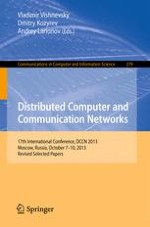This book constitutes the refereed proceedings of the 17th International Conference on Distributed Computer and Communication Networks, DCCN 2013, held in Moscow, Russia, in October 2013. The 22 revised full papers presented were carefully reviewed and selected from numerous submissions. The papers cover the following subjects: computer and communication networks architecture optimization; control in computer and communication networks; performance and QoS evaluation in wireless networks; modeling and simulation of network protocols; queueing theory; wireless IEEE 802.11, IEEE 802.15, IEEE 802.16 and UMTS (LTE) net-works; RFID technology and its application in intellectual transportation networks; protocols design (MAC, Routing) for centimeter and millimeter wave mesh networks; internet and web applications and services; application integration in distributed information systems.
